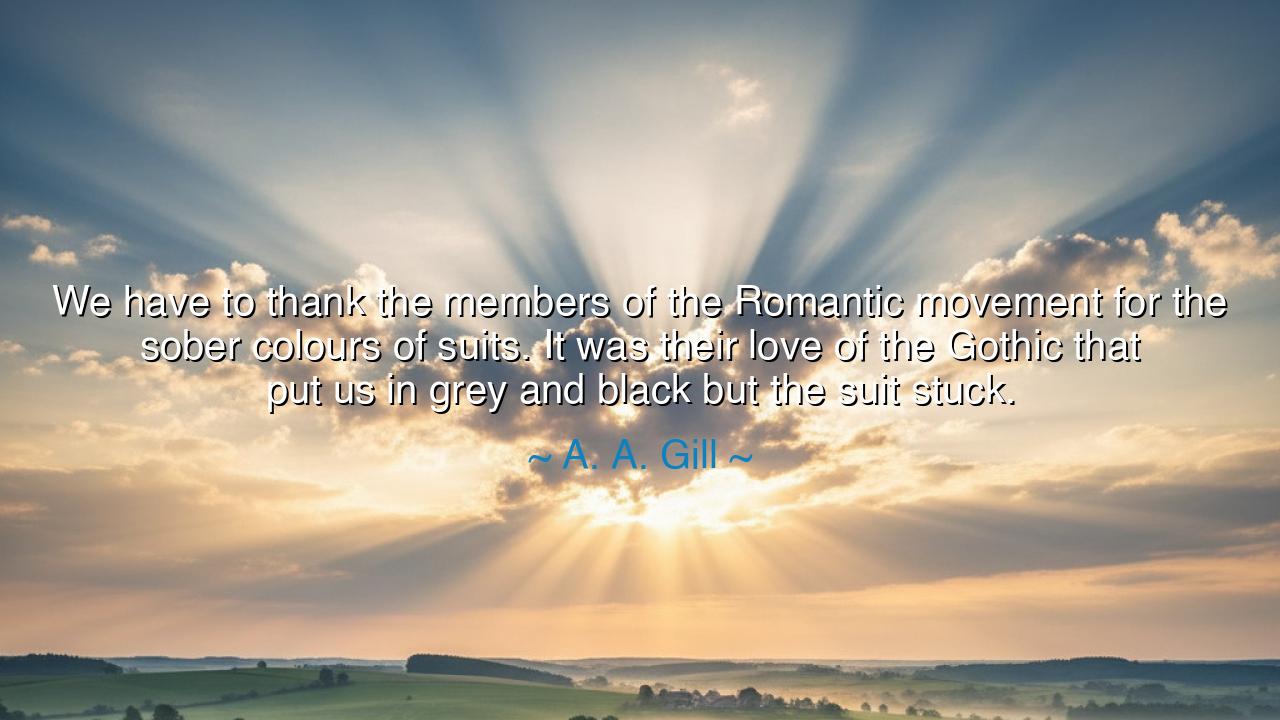
We have to thank the members of the Romantic movement for the
We have to thank the members of the Romantic movement for the sober colours of suits. It was their love of the Gothic that put us in grey and black but the suit stuck.






Hear the words of A. A. Gill, sharp observer of culture and history: “We have to thank the members of the Romantic movement for the sober colours of suits. It was their love of the Gothic that put us in grey and black but the suit stuck.” At first, these words may seem a jest upon fashion, but in truth they unveil a deep connection between art, philosophy, and the clothes we wear. For every garment carries with it the spirit of its age, and the simple suit that now defines modern respectability was born from the passions of poets and dreamers.
Before the Romantic movement, the world of men’s dress was ablaze with colour. In the courts of Europe, silk, embroidery, lace, and brilliant hues marked the attire of nobles and gentlemen. The powdered wig and the velvet coat were symbols of elegance. But with the coming of the Romantics in the late 18th and early 19th centuries, there arose a rejection of frivolity and excess. They sought depth, seriousness, and truth in art and life. Their fascination with the Gothic, with shadow, ruin, and mystery, changed not only literature and architecture but also how men clothed themselves. Out went the peacock colours; in came the austerity of black and grey.
The suit became the uniform of modern man, not as ornament but as symbol. Its dark tones reflected solemnity, humility, and restraint—virtues exalted by the Romantics as a counterpoint to the artificial brilliance of the Enlightenment courts. The hues of ash and shadow mirrored the landscapes of ruined abbeys and storm-swept moors painted in the age’s poetry. Just as Byron or Shelley wrapped their words in storm and melancholy, so too did men wrap their bodies in sombre cloth. Fashion became philosophy stitched into fabric.
History offers proof in the figure of Beau Brummell, the great arbiter of style in Regency England. Brummell abandoned lace and jewels in favour of simple, well-cut coats, immaculate linen, and dark colours. He was no Romantic poet, yet he embodied the Romantic aesthetic: simplicity that concealed refinement, austerity that suggested depth. In his influence, the suit was born, and it has endured for centuries as the attire of seriousness, respect, and authority.
What Gill reveals is the hidden power of movements of the spirit. The Romantic movement, which many think of only in terms of poetry and painting, shaped the very fabric of our daily lives. To wear a grey or black suit today, in a courtroom or a boardroom, is to walk still in the shadow of Byron, Wordsworth, and their Gothic fascination. The sombre suit is not merely a garment—it is the living relic of a revolution in taste, where passion for the mysterious reshaped the ordinary.
The deeper meaning of Gill’s words is this: culture is never confined to books and galleries. The choices of artists ripple outward until they shape how we speak, how we build, how we live, even how we dress. The suit you wear to work is not only cloth—it is history, philosophy, and art stitched together by centuries. The black and grey of your wardrobe are the colours of tombs and ruins, of Gothic arches and storm-lit landscapes, passed down through generations.
Therefore, children of tomorrow, learn from this truth: nothing in life is small or separate. The clothes on your back, the colours you choose, the patterns of your daily life—all are shaped by those who dreamed before you. Honor the visionaries, even in their strangeness, for their shadows still guide your steps. And when you choose your own path, remember that your art, your ideas, your movements may one day shape the very fabric others will wear.
Thus Gill’s words, spoken with wit, carry timeless wisdom: the Romantics clothed us in grey and black, and the suit has endured as their gift and burden. From their love of the Gothic we inherited solemnity, restraint, and elegance. And so we are reminded: what begins in the imagination of poets can, in time, define the very face of the world.






AAdministratorAdministrator
Welcome, honored guests. Please leave a comment, we will respond soon